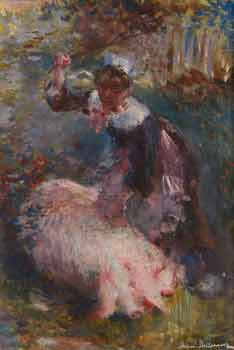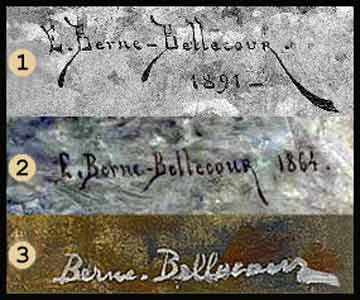France, (1838-1910)

-
La gardienne de cochon
- [The pig keeper]
- (ndg.), oil on canvas
- 15 x 21.9 in. (38 x 55.5 cm.)
- Private collection
-
Editor’s Note:
The actual artist behind this work is in some doubt here at the Porkopolis Art Museum. No definitive or authoritative source could be found that cites E. Berne-Bellecour as the artist. The Askart.com & Arcadja.com sales and auction services list the artist as “Berne Dethcourt (19-20th cent.)” which could also be read as “Berne Delcourt.”
Also, this work is certainly in the impressionist style while most of E. Berne-Bellecour’s military subjects are exicuted in a precise realist style. The signature on this painting appears to say simply “Berne-Bellecour” and is written in a heavy and generic script. Much of Etienne Prosper Berne-Bellecour’s work is signed with a printed “E. Berne-Bellecour” in a light hand with elongated serifs on the letters b and r. See the image below for a comparison.
Signatures of two of E. Berne-Bellecour’s familiar works are compared to the painting on display for this exhibition in the image below:

1) Picket Guards (1891)
2) Low Road on the Coast of Normandy (1864)
3) La gardienne de cochon (ndg.)So, we have a bit of a mystery at work, but this painting was considered too beautiful to be left out of the exhibition. The very idea of an exhibition focused on pig-themed art, let alone an entire museum on that subject, seems to foster controversy. But what is art without controversy? And this is a little bit more… If you have information to share on this work and it’s creator please use the contact form. I’d like to hear from you.
About the Artist:
Etienne Prosper Berne-Bellecour (1838-1910), was a French painter, printmaker, and illustrator who is known mostly for his war art. He also attended the École des Beaux-Arts and competed for the Prix de Rome in 1859. He also practiced as a photographer, sculptor and an etcher. Initially he painted landscapes and portraits, and worked in photography to support himself.
Berne-Bellecour went on a trip to Africa in 1870, later returning to serve in the Franco-Prussian War in the Francs-tireurs and won a medal for gallantry under fire. His later works focused on military subjects. Berne-Bellecour was named a Chevalier in the French Legion of Honor in 1878. [DES-01/16]


